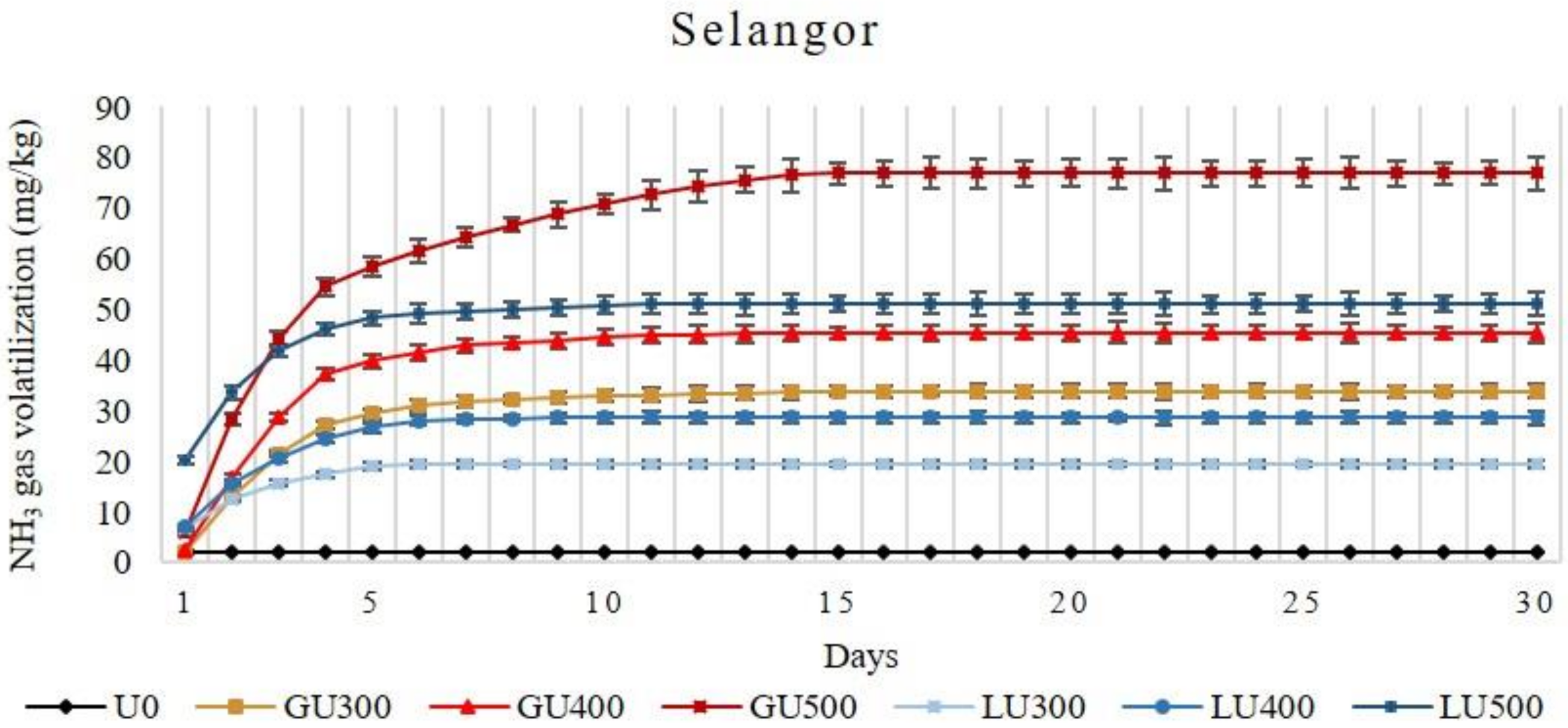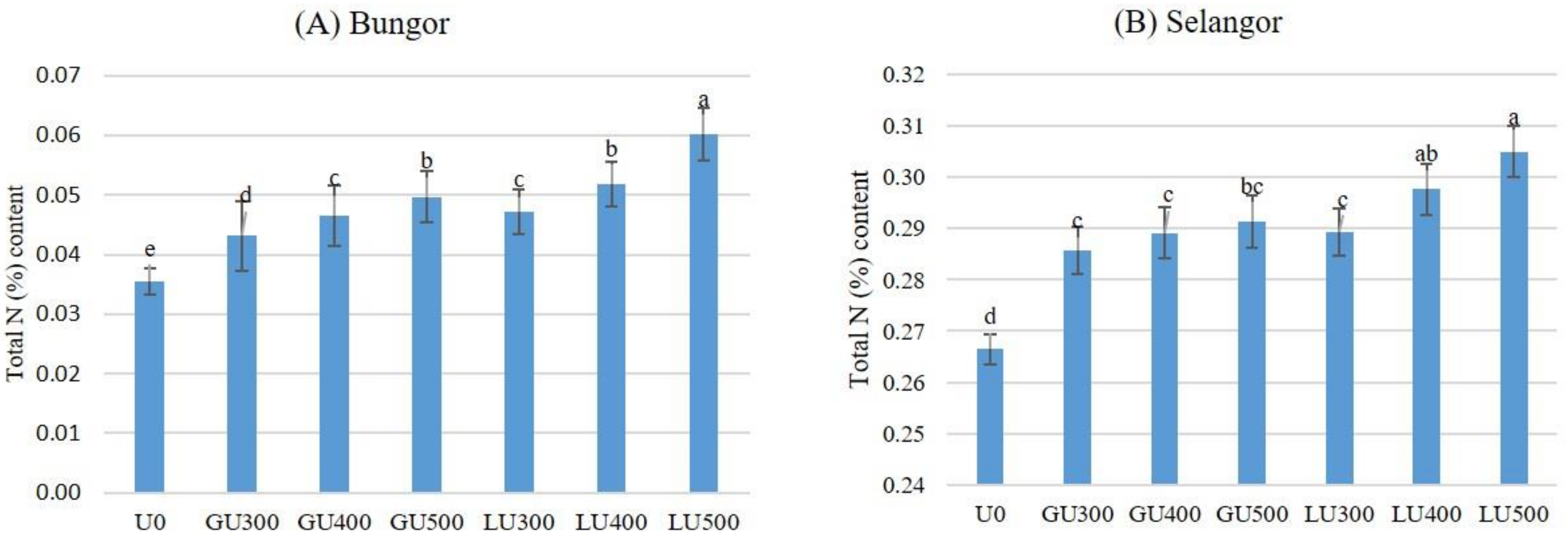Gaseous Nitrogen Losses from Tropical Soils with Liquid or Granular Urea Fertilizer Application
Abstract
:1. Introduction
2. Materials and Methods
Statistical Analysis
3. Results
3.1. NH3 Gas Volatilization Loss
3.2. N2O Gas Emission Loss
3.3. Total N (%) Remaining in the Soils
3.4. Total N Loss (%) from the Soil
4. Discussion
5. Conclusions
Author Contributions
Funding
Institutional Review Board Statement
Informed Consent Statement
Data Availability Statement
Acknowledgments
Conflicts of Interest
References
- Erisman, J.W.; Galloway, J.N.; Seitzinger, S.; Bleeker, A.; Dise, N.B.; Petrescu, A.M.R.; Leach, A.M.; de Vries, W. Consequences of human modification of the global nitrogen cycle. Philos. Trans. R. Soc. B Biol. Sci. 2013, 368, 20130116. [Google Scholar] [CrossRef] [Green Version]
- Kira, O.; Shaviv, A.; Dubowski, Y. Direct tracing of NH3 and N2O emissions associated with urea fertilization approaches, using static incubation cells. Sci. Total Environ. 2019, 661, 75–85. [Google Scholar] [CrossRef] [PubMed]
- Sutton, M.A.; Oenema, O.; Erisman, J.W.; Leip, A.; van Grinsven, H.; Winiwarter, W. Too much of a good thing. Nature 2011, 472, 159–161. [Google Scholar] [CrossRef] [Green Version]
- Heffer, P.; Prud’homme, M. Short-Term Fertilizer Outlook 2016–2017; International Fertilizer Industry Association: Paris, France, 2016. [Google Scholar]
- Almaz, M.G.; Halim, R.A.; Martini, M.Y.; Samsuri, A.W. Integrated application of poultry manure and chemical fertiliser on soil chemical properties and nutrient uptake of maize and soybean. Malays. J. Soil Sci. 2017, 21, 13–28. [Google Scholar]
- Wang, S.; Shan, J.; Xia, Y.; Tang, Q.; Xia, L.; Lin, J.; Yan, X. Different effects of biochar and a nitrification inhibitor application on paddy soil denitrification: A field experiment over two consecutive rice-growing seasons. Sci. Total Environ. 2017, 593, 347–356. [Google Scholar] [CrossRef] [PubMed] [Green Version]
- Behera, S.N.; Sharma, M.; Aneja, V.P.; Balasubramanian, R. Ammonia in the atmosphere: A review on emission sources, atmospheric chemistry and deposition on terrestrial bodies. Environ. Sci. Pollut. Res. 2013, 20, 8092–8131. [Google Scholar] [CrossRef] [PubMed]
- Reay, D.S.; Davidson, E.A.; Smith, K.A.; Smith, P.; Melillo, J.M.; Dentener, F.; Crutzen, P.J. Global agriculture and nitrous oxide emissions. Nat. Clim. Chang. 2012, 2, 410–416. [Google Scholar] [CrossRef]
- Zhang, X.; Davidson, E.A.; Mauzerall, D.L.; Searchinger, T.D.; Dumas, P.; Shen, Y. Managing nitrogen for sustainable development. Nature 2015, 528, 51–59. [Google Scholar] [CrossRef] [Green Version]
- Puga, A.P.; Grutzmacher, P.; Cerri, C.E.P.; Ribeirinho, V.S.; de Andrade, C.A. Biochar-based nitrogen fertilizers: Greenhouse gas emissions, use efficiency, and maize yield in tropical soils. Sci. Total Environ. 2020, 704, 135375. [Google Scholar] [CrossRef] [PubMed]
- Lichiheb, N.; Myles, L.T.; Personne, E.; Heuer, M.; Buban, M.; Nelson, A.J.; Koloutsou-Vakakis, S.; Rood, M.J.; Joo, E.; Miller, J.; et al. Implementation of the effect of urease inhibitor on ammonia emissions following urea-based fertilizer application at a Zea mays field in central Illinois: A study with SURFATM-NH 3 model. Agric. For. Meteorol. 2019, 269–270, 78–87. [Google Scholar] [CrossRef]
- Bortoletto-Santos, R.; Cavigelli, M.A.; Montes, S.E.; Schomberg, H.H.; Le, A.; Thompson, A.I.; Kramer, M.; Polito, W.L.; Ribeiro, C. Oil-based polyurethane-coated urea reduces nitrous oxide emissions in a corn fi eld in a Maryland loamy sand soil. J. Clean. Prod. 2020, 249, 119329. [Google Scholar] [CrossRef]
- da Silva, M.J.; Franco, H.C.J.; Magalhães, P.S.G. Liquid fertilizer application to ratoon cane using a soil punching method. Soil Tillage Res. 2017, 165, 279–285. [Google Scholar] [CrossRef]
- Rimski-Korsakov, H.; Rubio, G.; Lavado, R.S. Fate of the nitrogen from fertilizers in field-grown maize. Nutr. Cycl. Agroecosyst. 2012, 93, 253–263. [Google Scholar] [CrossRef]
- Randall, G.W.; Sawyer, J. Nitrogen Application Timing, Forms, and Additives. Available online: https://elibrary.asabe.org/abstract.asp?aid=24245 (accessed on 18 May 2018).
- Hyatt, C.R.; Venterea, R.T.; Rosen, C.J.; Wilson, M.L.; Dolan, M.S. Polymer-Coated Urea Maintains Potato Yields and Reduces Nitrous Oxide Emissions in a Minnesota Loamy Sand. Soil Sci. Soc. Am. J. 2010, 74, 419–428. [Google Scholar] [CrossRef]
- Keerio, H.A.; Bae, W.; Park, J.; Kim, M. Substrate uptake, loss, and reserve in ammonia-oxidizing bacteria (AOB) under different substrate availabilities. Process Biochem. 2020, 91, 303–310. [Google Scholar] [CrossRef]
- Signor, D.; Eduardo, C.; Cerri, P. Nitrous oxide emissions in agricultural soils: A review 1. Pesqui. Agropecu. Trop. 2013, 2013, 322–338. [Google Scholar] [CrossRef]
- Jones, C. Ammonia Volatilization: Process, Amounts, and Effects on Yield and Protein. Available online: http://landresources.montana.edu/soilfertility (accessed on 22 February 2020).
- Alves, I.; Degaspari, M.; Rodrigues, J.; Zaqueu, S.; Montezano, F.; Vitti, C.; Rossetto, R.; Del, S.J.; Andre, G. Nitrogen sources and application rates affect emissions of N2O and NH3 in sugarcane. Nutr. Cycl. Agroecosyst. 2020, 116, 329–344. [Google Scholar] [CrossRef]
- Yao, Y.; Zeng, K.; Song, Y. Biological nitrification inhibitor for reducing N2O and NH3 emissions simultaneously under root zone fertilization in a Chinese rice field. Environ. Pollut. 2020, 264, 114821. [Google Scholar] [CrossRef] [PubMed]
- LECO. LECO Corporation. Available online: https://www.leco.com/about-us/corporate/approved-methods (accessed on 30 November 2018).
- Chapman, H.D. Cation-exchange capacity. Methods Soil Anal. Part 2 Chem. Microbiol. Prop. 1965, 9, 891–901. [Google Scholar]
- Keeney, D.R. Nitrogen—Availability indices. In Methods of Soil Analysis: Part 2 Chemical and Microbiological Properties; Page, A.L., Ed.; John Wiley & Sons, Inc.: Hoboken, NJ, USA, 1983; Volume 9, pp. 711–733. [Google Scholar]
- Teh, C.B.S.; Talib, J. Soil and Plant Analyses Vol. I Soil Physics Analyses; Department of Land Management, Faculty of Agriculture, Universiti Putra Malaysia: Seri Kembangan, Malaysia, 2006; Volume 1, ISBN 983-3455-64-6. [Google Scholar]
- Tan, K.H. Determination of soil water. In Soil Sampling, Preparation, and Analysis, 2nd ed.; CRC Press: Boca Raton, FL, USA, 2005; Volume 1, ISBN 9780849334993. [Google Scholar]
- Min, L.W. Reconnaissance Soil Survey of Raub-Temerloh-Jerantut Region Northwest Pahang; Soil Science Division, Research Branch, Division of Agriculture, Ministry of Agriculture and Co-Operatives: Kuala Lumpur, Malaysia, 1967; Volume 2. [Google Scholar]
- Fenn, L.B.; Kissel, D.E. Ammonia volatilization from surface applications of ammonium compounds on calcareous soils: I. General theory. Soil Sci. Soc. Am. J. 1973, 37, 855–859. [Google Scholar] [CrossRef]
- SAS Institute Inc. SAS® 9.4 Statements Reference. 2013. Available online: https://www.sas.com/ro_ro/home.html?gclid=CjwKCAiA1eKBBhBZEiwAX3gql-7WYG5CxvSd5EDWKohWu3nVvb0RRsgLupYC7rC0hWqRVAvu7oOHJhoCWVMQAvD_BwE (accessed on 3 February 2021).
- Mariano, E.; de Sant Ana Filho, C.R.; Bortoletto-Santos, R.; Bendassolli, J.A.; Trivelin, P.C.O. Ammonia losses following surface application of enhanced-efficiency nitrogen fertilizers and urea. Atmos. Environ. 2019, 203, 242–251. [Google Scholar] [CrossRef]
- Abera, G.; Wolde-meskel, E.; Beyene, S.; Bakken, L.R. Nitrogen mineralization dynamics under different moisture regimes in tropical soils. Int. J. Soil Sci. 2012, 7, 132. [Google Scholar] [CrossRef] [Green Version]
- Cantarella, H.; Mattos, D.; Quaggio, J.A.; Rigolin, A.T. Fruit yield of Valencia sweet orange fertilized with different N sources and the loss of applied N. Nutr. Cycl. Agroecosyst. 2003, 67, 215–223. [Google Scholar] [CrossRef]
- Vitti, A.C.; Trivelin, P.C.O.; Gava, G.J.D.C.; Franco, H.C.J.; Bologna, I.R.; Faroni, C.E. Sugar cane yield AS related to the location of nitrogen fertilizer applied on top of unburnt sugar caneresidues. Rev. Bras. Ciência Solo 2007, 31, 491–498. [Google Scholar] [CrossRef] [Green Version]
- Rochette, P.; Angers, D.A.; Chantigny, M.H.; Gasser, M.; Macdonald, J.D.; Pelster, D.E.; Bertrand, N. NH3 volatilization, soil NH4 concentration and soil pH following subsurface banding of urea at increasing rates. Can. J. Soil Sci. 2013, 93, 261–268. [Google Scholar] [CrossRef] [Green Version]
- Pan, B.; Kee, S.; Mosier, A.; Luo, Y.; Chen, D. Agriculture, Ecosystems and Environment Ammonia volatilization from synthetic fertilizers and its mitigation strategies: A global synthesis. Agric. Ecosyst. Environ. 2016, 232, 283–289. [Google Scholar] [CrossRef]
- De Marchi, T.; Silva, F.; Braz, V.; Oliveira, D.; Pontes, O.; Sergio, P. Geoderma Regional Soil nitrogen dynamics under tobacco with different fertilizer management in southern Brazil. Geoderma Reg. 2020, 21, e00282. [Google Scholar] [CrossRef]
- Holcomb, J.C.; Sullivan, D.M.; Horneck, D.A.; Clough, G.H. Effect of Irrigation Rate on Ammonia Volatilization. Soil Sci. Soc. Am. J. 2011, 75, 2341–2347. [Google Scholar] [CrossRef]
- Doyle, S. Liquid Nitrogen: Pros and Cons of Different Formulations—GRDC. Available online: https://grdc.com.au/resources-and-publications/grdc-update-papers/tab-content/grdc-update-%0A%09papers/2013/03/liquid-nitrogen-pros-and-cons-of-different-formulations%0A (accessed on 26 November 2020).
- Fu, W.; Wang, X.; Wei, X. Science of the Total Environment No response of soil N mineralization to experimental warming in a northern middle-high latitude agro-ecosystem. Sci. Total Environ. 2019, 659, 240–248. [Google Scholar] [CrossRef]
- Pelster, D.E.; Watt, D.; Strachan, I.B.; Rochette, P.; Bertrand, N.; Chantigny, M.H. Effects of initial soil moisture, clod size, and clay content on ammonia volatilization after subsurface band application of urea. J. Environ. Qual. 2019, 48, 549–558. [Google Scholar] [CrossRef] [Green Version]
- Cardenas, L.M.; Bhogal, A.; Chadwick, D.R.; Mcgeough, K.; Misselbrook, T.; Rees, R.M.; Thorman, R.E.; Watson, C.J.; Williams, J.R.; Smith, K.A.; et al. Science of the Total Environment Nitrogen use ef fi ciency and nitrous oxide emissions from fi ve UK fertilised grasslands. Sci. Total Environ. 2019, 661, 696–710. [Google Scholar] [CrossRef]
- Brentrup, F.; Kusters, J.; Lammel, J.; Kuhlmann, H. Methods to estimate on-field nitrogen emissions from crop production as an input to LCA studies in the agricultural sector. Int. J. Life Cycle Assess. 2000, 5, 349–357. [Google Scholar] [CrossRef]
- Cameron, K.C.; Di, H.J.; Moir, J.L. Nitrogen losses from the soil/plant system: A review. Ann. Appl. Biol. 2013, 162, 145–173. [Google Scholar] [CrossRef]
- Wu, H.; Du, S.; Zhang, Y.; An, J.; Zou, H.; Zhang, Y.; Yu, N. Effects of irrigation and nitrogen fertilization on greenhouse soil organic nitrogen fractions and soil-soluble nitrogen pools. Agric. Water Manag. 2019, 216, 415–424. [Google Scholar] [CrossRef]
- Chantigny, M.H.; Curtin, D.; Beare, M.H.; Greenfield, L.G. Influence of Temperature on Water-Extractable Organic Matter and Ammonium Production in Mineral Soils. Soil Sci. Soc. Am. J. 2010, 74, 517–524. [Google Scholar] [CrossRef]
- Mukhopadhyay, S.; Masto, R.E.; Tripathi, R.C.; Srivastava, N.K. Application of Soil Quality Indicators for the Phytorestoration of Mine Spoil Dumps; Elsevier Inc.: Amsterdam, The Netherlands, 2019; ISBN 9780128139134. [Google Scholar]





| Soil Properties | Bungor Soil | Selangor Soil |
|---|---|---|
| Texture analysis | Clay: 28.44% Silt: 2.28% Sand: 69.28% | Clay: 68.11% Silt: 29.85% Sand: 2.04% |
| USDA soil texture class | Sandy clay loam [27] | Clay |
| Moisture content at field capacity (%) | 23.74 | 27.89 |
| pH | 4.93 | 6.03 |
| Total C (%) | 1.41 | 3.46 |
| Total N (%) | 0.07 | 0.27 |
| NH4+-N (mg/kg) | 16.31 | 10.07 |
| NO3−-N (mg/kg) | 11.41 | 27.11 |
| CEC (cmol+/kg) | 5.78 | 16.48 |
| Urea Treatment (mg/kg) | N Loss (%) | |
|---|---|---|
| Bungor Soil (Mean ± 1 SE) | Selangor Soil (Mean ± 1 SE) | |
| GU300 | 74.60 ± 0.851 a * | 68.98 ± 0.871 a |
| GU400 | 72.45 ± 0.821 ab | 69.32 ± 0.927 a |
| GU500 | 71.60 ± 0.558 b | 70.10 ± 0.817 a |
| LU300 | 60.77 ± 0.789 c | 44.58 ± 0.597 c |
| LU400 | 59.18 ± 0.754 c | 46.74 ± 0.451 c |
| LU500 | 50.59 ± 0.815 d | 49.95 ± 0.990 b |
| LSD0.05 | 2.2901 | 2.3715 |
Publisher’s Note: MDPI stays neutral with regard to jurisdictional claims in published maps and institutional affiliations. |
© 2021 by the authors. Licensee MDPI, Basel, Switzerland. This article is an open access article distributed under the terms and conditions of the Creative Commons Attribution (CC BY) license (http://creativecommons.org/licenses/by/4.0/).
Share and Cite
Motasim, A.M.; Samsuri, A.W.; Abdul Sukor, A.S.; Adibah, A.M. Gaseous Nitrogen Losses from Tropical Soils with Liquid or Granular Urea Fertilizer Application. Sustainability 2021, 13, 3128. https://doi.org/10.3390/su13063128
Motasim AM, Samsuri AW, Abdul Sukor AS, Adibah AM. Gaseous Nitrogen Losses from Tropical Soils with Liquid or Granular Urea Fertilizer Application. Sustainability. 2021; 13(6):3128. https://doi.org/10.3390/su13063128
Chicago/Turabian StyleMotasim, Ahmmed Md, Abd Wahid Samsuri, Arina Shairah Abdul Sukor, and Amin Mohd Adibah. 2021. "Gaseous Nitrogen Losses from Tropical Soils with Liquid or Granular Urea Fertilizer Application" Sustainability 13, no. 6: 3128. https://doi.org/10.3390/su13063128







